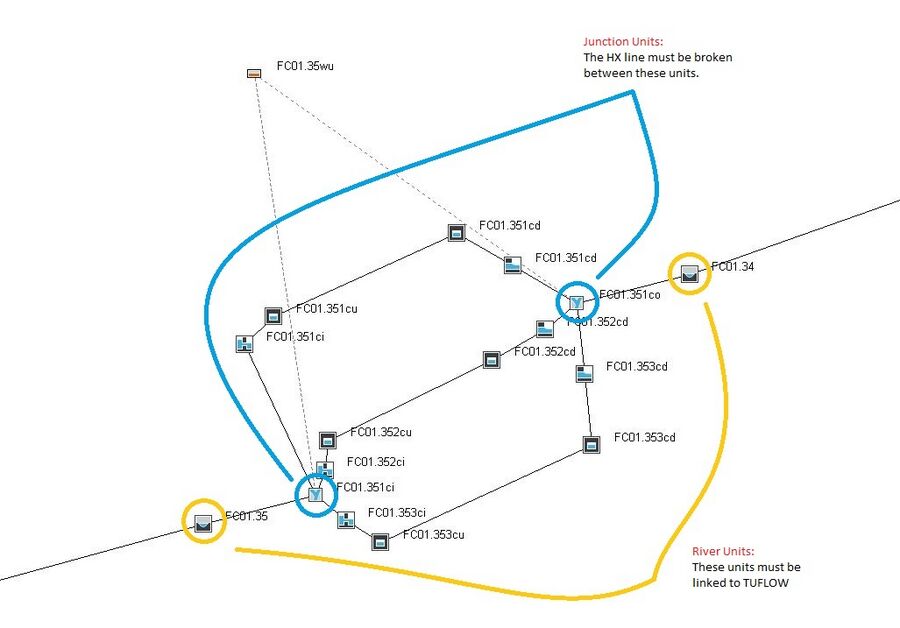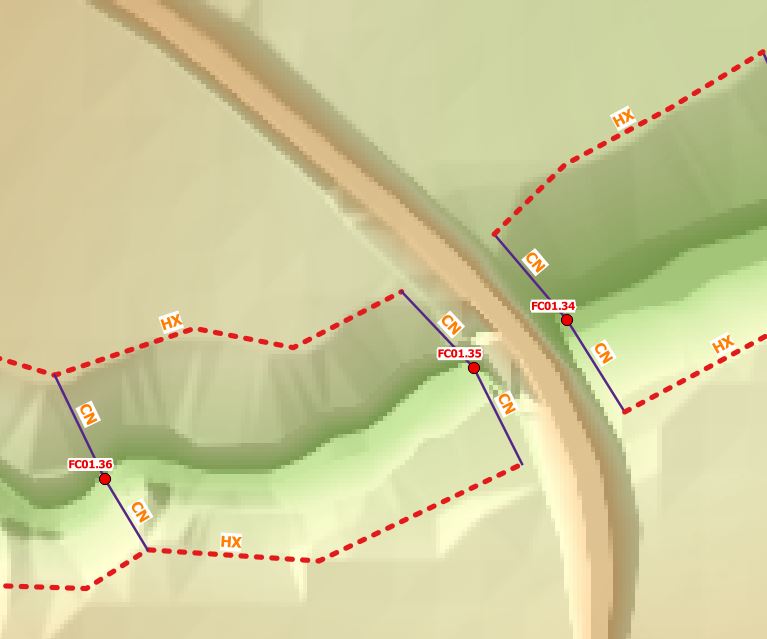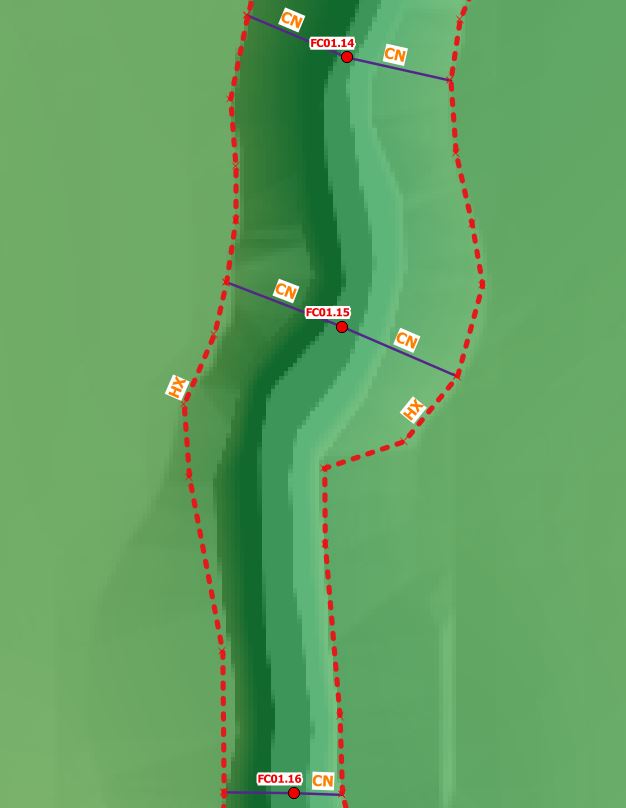1D-2D Flood Modeller-TUFLOW
THIS PAGE IS CURRENTLY UNDER CONSTRUCTION
Introduction
TUFLOW models can be configured to dynamically link to Flood Modeller models by utilising a water level boundary to the 2D cells along the 1D/2D interface. In the 2D boundary condition (2d_bc) GIS layer, we define the location at which this link occurs. The 2D water level applied at the 2D boundary cells is calculated in the 1D Flood Modeller component. The terminology used in TUFLOW is a HX type boundary on the 2D cells, with the H indicating that a Head (water level) boundary is used and the X indicating the value is coming from an eXternal model (in this case Flood Modeller).
Depending on the water level in the surrounding 2D cells, flow can either enter or leave the HX cells. The volume of water entering or leaving the 2D boundary is added or subtracted from the 1D Flood Modeller model to preserve volume. We must connect the HX lines to the 1D Flood Modeller model. This is done using CN type lines in the 2d_bc layer, where a CN line is connected to the HX line, the water level from the 1D Flood Modeller nodes is transferred to the HX line. In between 1D nodes, a linear interpolation of water level is applied. This is shown in the figure below.

Once the water level in Flood Modeller exceeds the elevation in the boundary cell water can enter or leave the model. Similar to a Flood Modeller lateral spill or lateral inflow, the discharge is distributed laterally along the length of the HX line. Note that it is the elevation of the HX boundary cell centres that determines when the spill starts to occur and not the cross section within Flood Modeller. If there is a levee or flood defence, it is important that we use breaklines in the model to ensure that the elevations of the 2D cells are consistent with the levee crest. The next four images show a section view of the 1D/2D link and how this may progress during a flood event.
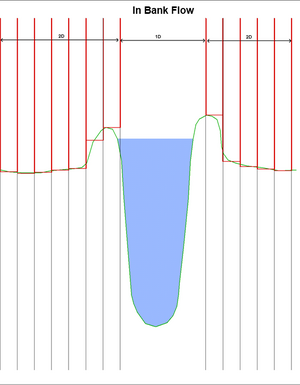
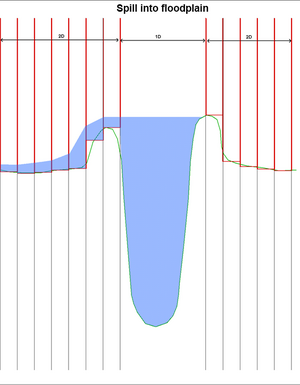
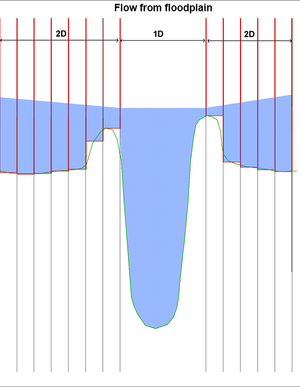
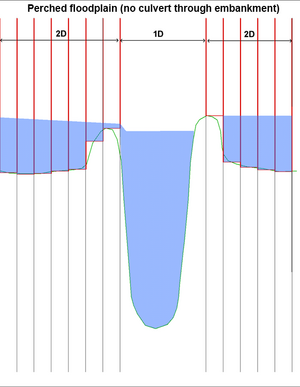
Often HX lines are located along the top of a levee (natural or artificial) or flood defence running along the river bank. When carving a 1D channel through a 2D domain, the HX line must be either on the top of the levee or on the inside of the levee (closest to the channel). If the HX line is located on the other side of the levee away from the channel, the effect of the levee on water flow is not modelled. In the image above, it can be seen that the boundary cell is along the levee and the interaction between the channel and the floodplain (1D and 2D) occurs at the correct elevation.
Building a Flood Modeller-TUFLOW 1D-2D Connection
Flood Modeller and TUFLOW will be considered linked if a Flood Modeller node in a 1d_x1D layer is snapped to a TUFLOW CN line which in turn is snapped to a TUFLOW HX line in a 2d_bc file. ‘CN’ or connection lines read the water level from Flood Modeller and transfers this to the HX line.
In the figure below, the water level is calculated in Flood Modeller at the nodes FC01.16, FC01.15 and FC01.14. These water levels are linearly interpolated along the lengths of the HX line on each of the left and right banks of the watercourse. When the water level exceeds the ZC elevation of the boundary cell, water is able to flow out onto the TUFLOW 2D floodplain.
The digitised direction of the HX and CN lines is not important. The CN lines however should be digitised approximately perpendicular to the direction of flow. Two CN lines are digitised for each node and snapped to the HX boundary lines along the left and right banks at vertices. Both CN and HX lines are digitised within the same 2d_bc file, on a basic approach, you only need to input the type attribute (either CN or HX). It is also recommended to input an f attribute value of 1 for CN lines for clarity, however if left at zero TUFLOW will by default change this value to 1. There are a range of Flags that can be used within the 2d_bc file, also D values to change elevations of the link cells and also A values to change the storage across the cells. Further information on these can be found within the TUFLOW manual.
The HX boundary lines should be digitised along the top of each bank such that the width between the lines approximately correlates to the width of the 1D channel. This is important so as not to either over/under compensate flow area between the two solvers.
Note that where there are junctions within the Flood Modeller 1D model (i.e. at structures), both the nodes immediately upstream and downstream must be connected to TUFLOW. Refer to the below figure where the junctions are circled in blue and the upstream and downstream RIVER units are circled in yellow. The HX lines must be broken between the junctions as this is a requirement of a linked Flood Modeller – TUFLOW model.
In the example below, the HX lines are broken between FC01.35 and FC01.34 as a culvert is located between these nodes.
